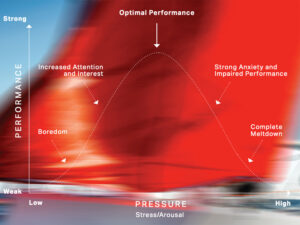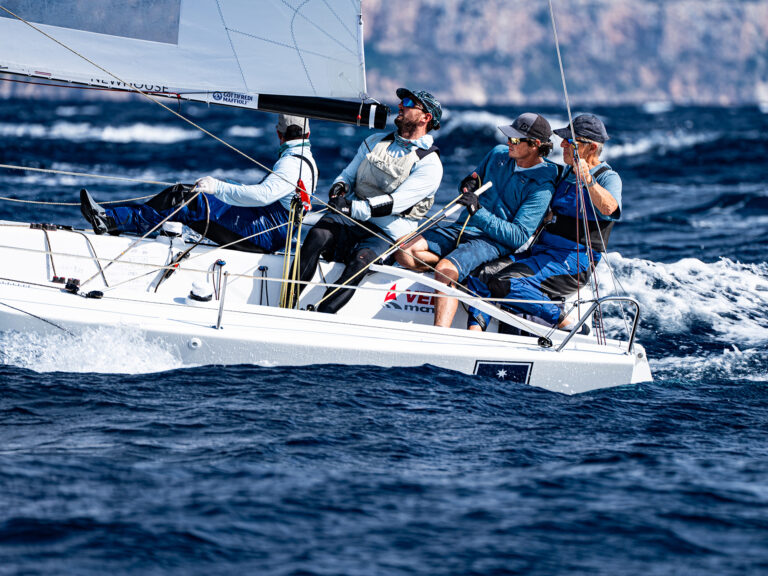
rules at marks for multiple boats
This is the third in a series of articles on the changes in the racing rules for 2013. In the first two we looked at implications of the changes to the definition Mark-Room. Now, we discuss changes in two rules of Section C that apply at marks and obstructions: Rules 18.3 and 20.
There are two changes in Rule 18.3, Tacking in the Zone. The first sentence has been rewritten and shortened. Gone is the reference to Rule 13 so that you don’t have to flip back and forth between rules as you read, and the condition under which Rule 18.3 applies is simply that, while one boat is fetching a mark, another boat turns past head to wind in the zone and is then on the same tack as the boat that is fetching.
The second change is a small one that might not be easily noticed. In Rule 18.3(a), the word “her” has been changed to “contact” so that the rule reads: “[The boat that changed tack] shall not cause the [boat fetching the mark] to sail above close-hauled to avoid contact …”
This change makes Rule 18.3(a) serve its intended purpose when, as shown in the first diagram, two port-tack boats tack in the zone to leeward of a starboard-tack boat that is fetching the mark. The intent here is that a boat subject to Rule 18.3(a) fouls whenever she causes a boat that is fetching to sail above a close-hauled course.
I will apply the 2013 rules to the incident in the diagram. Steve is approaching a windward mark that he is required to leave to port. He is on starboard tack and is fetching the mark. In position 2, both Mary and Tom are in the zone on port tack and on collision courses with Steve. Mary and Tom both tack in the zone onto the same tack that Steve is on. Therefore, Rule 18.3 applies between Mary and Steve, and also between Tom and Steve.
After Mary and Tom complete their tacks at position 3, there is space for Mary to sail to the mark on a close-hauled starboard-tack course and leave it to port without causing Steve to sail above close-hauled. However, Tom cannot leave the mark to port without luffing above close-hauled. Tom does luff, and his luff causes both Mary and Steve to luff above close-hauled to avoid contact. Therefore, Tom breaks Rule 18.3(a). Note that the use of the word “contact” in Rule 18.3(a) is crucial. When Steve luffs, he is luffing to avoid contact with Mary, and not Tom. Therefore, if the word “her” were still in the rule where “contact” is now, Tom would not have broken Rule 18.3(a).
When Tom luffed, Mary was compelled to luff in order to keep clear of Tom as required by Rule 11 and to avoid contact with Tom as required by Rule 14. When Mary luffed above close-hauled she caused Steve to luff above close-hauled to avoid contact, and so Mary also broke Rule 18.3(a). But Mary was compelled to break Rule 18.3(a) by Tom’s breach of that same rule. Therefore, Mary is exonerated for breaking Rule 18.3(a) because she broke it “as a consequence of” Tom’s breach (see Rule 64.1(a)).
If you’ve studied physics or played pool, you probably know that it’s much easier to predict the movement of two pool balls after they collide than it is to predict the movement of three pool balls after they all collide. Well, it’s much easier to write a racing rule for a situation involving just two boats than it is to write the same rule for three or more boats. Rule 18.3, as discussed above, and Rule 20, as discussed below, have been changed to make them “work” for multiple boat situations.
Rule 20 is a safety rule that enables us to avoid obstructions while beating to windward. It’s been in the book for over 50 years. This year, it’s been reorganized and three additions have been made.
In the reorganized rule, Rule 20.1 states when a boat may hail for room to tack at an obstruction and when she may not; Rule 20.2 states what must happen after a boat hails for room to tack; and Rule 20.3 is a new rule that enables Rule 20 to work smoothly for three or more boats. Last year’s rule 20.2, Exoneration, is now part of new Rule 21, which we will discuss next month.
The first addition to Rule 20 is Rule 20.2(b), which, to enhance safety, states that whenever you are hailed by another boat for room to tack you must give the hailing boat room to tack even if the hail broke Rule 20.1 and even if you are not aware of any obstruction nearby. After you have given room, if you believe the hail broke Rule 20.1, you may protest. The hailing boat may then take a Two-Turns Penalty, and if she does not and you write up your protest, the protest committee should disqualify her if it finds that she broke Rule 20.1.
The second addition to Rule 20 is Rule 20.2(e). It clarifies what happens when both Rule 18.2 and Rule 20 apply at the same time in the zone. Look again at the first diagram. At position 2, Mary owes Tom mark-room under Rule 18.2(b) because she and Tom were overlapped when they entered the zone. Steve is an obstruction to Tom and Mary, and Mary would have to make a substantial course change to avoid Steve. Therefore, Mary has the right to hail Tom for room to tack. Rule 20.2(e) states that, if Mary does hail, Rule 18.2 ceases to apply between Mary and Tom, and Tom must give Mary room to tack, even if doing so means he no longer has room to leave the mark to port. (New Rule 20.2(e) was implied in the 2009-2012 rules by the last sentence of the preamble to Section C, which was so obscure that few sailors understood it.)

The third addition to Rule 20 is new Rule 20.3. The second diagram shows a three-boat situation in which it applies. Larry, Moe, and Curly, sailing close-hauled on starboard tack, are nearing an obstruction (a point of land). If none of them changed course, Larry would run aground, but Moe and Curly would pass the point safely. Larry hails Moe for room to tack. Rule 20.2(b) requires Moe to give Larry room, and Moe intends to do so by tacking. But Moe can’t tack without colliding with Curly. What’s more, if Moe hailed Curly for room to tack he would break Rule 20.1(a) because he can safely avoid the point without making any course change. Rule 20.3 gives Moe the right to hail (thereby, as the rule’s title implies, “passing on” Larry’s hail to Curly, the “additional boat”). Rule 20.3 also exempts Moe from penalty under Rule 20.1(a).
To sum up the implications of new Rules 20.2(b) and 20.3: Whenever you are hailed for room to tack, respond as required by Rule 20.2. If there are several boats stacked up approaching the shore, then a hail from the leeward-most boat may be passed on “up the stack” by the boat next to her to the windward boats so that every boat in the stack can avoid piling onto the shore.









